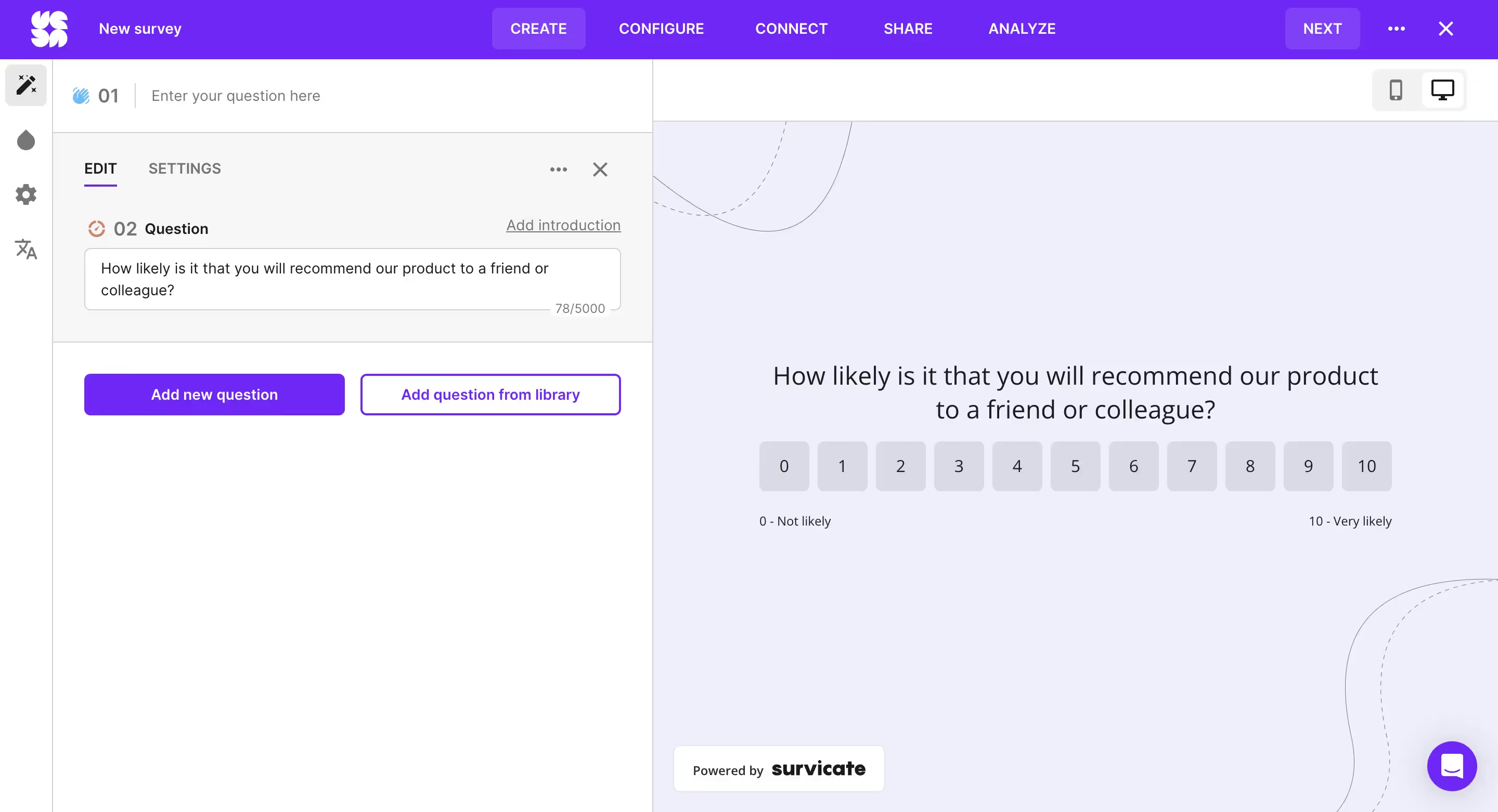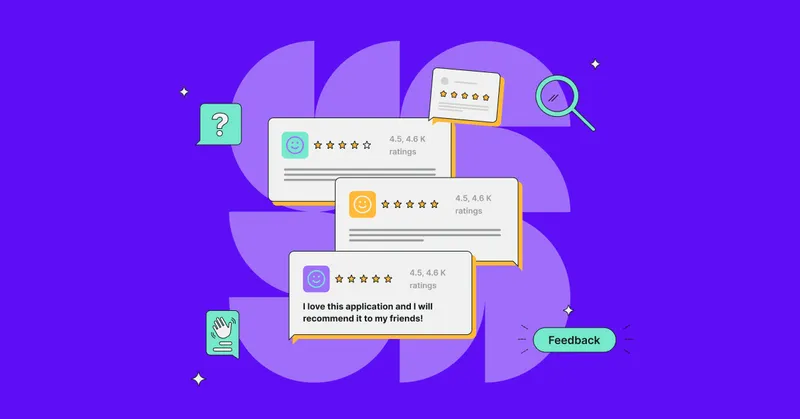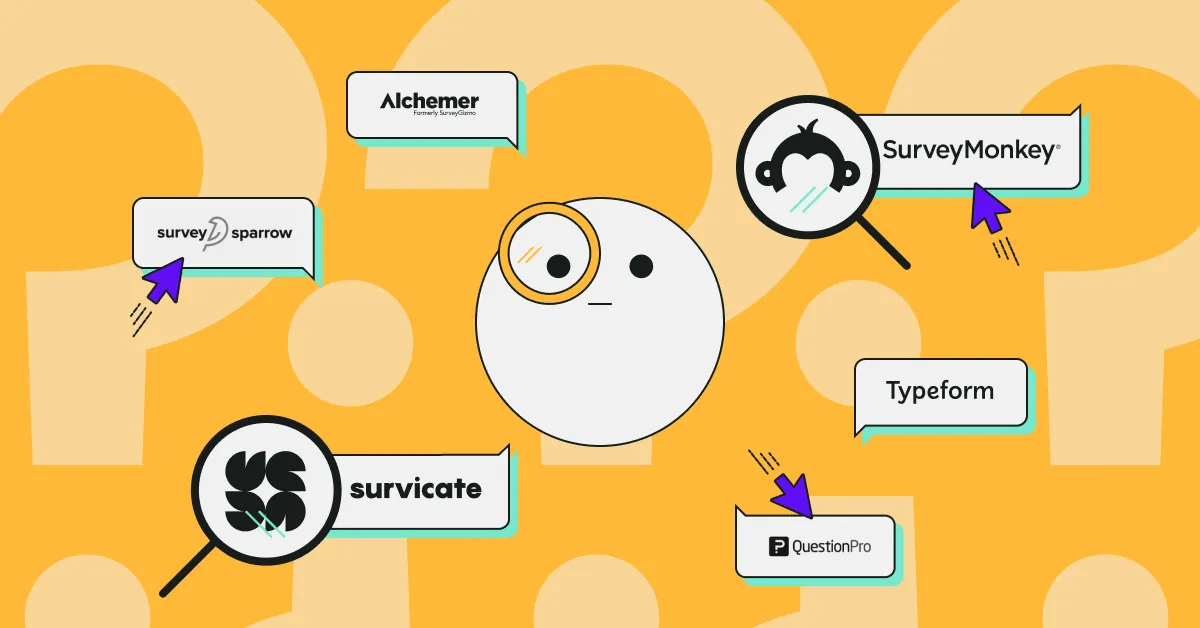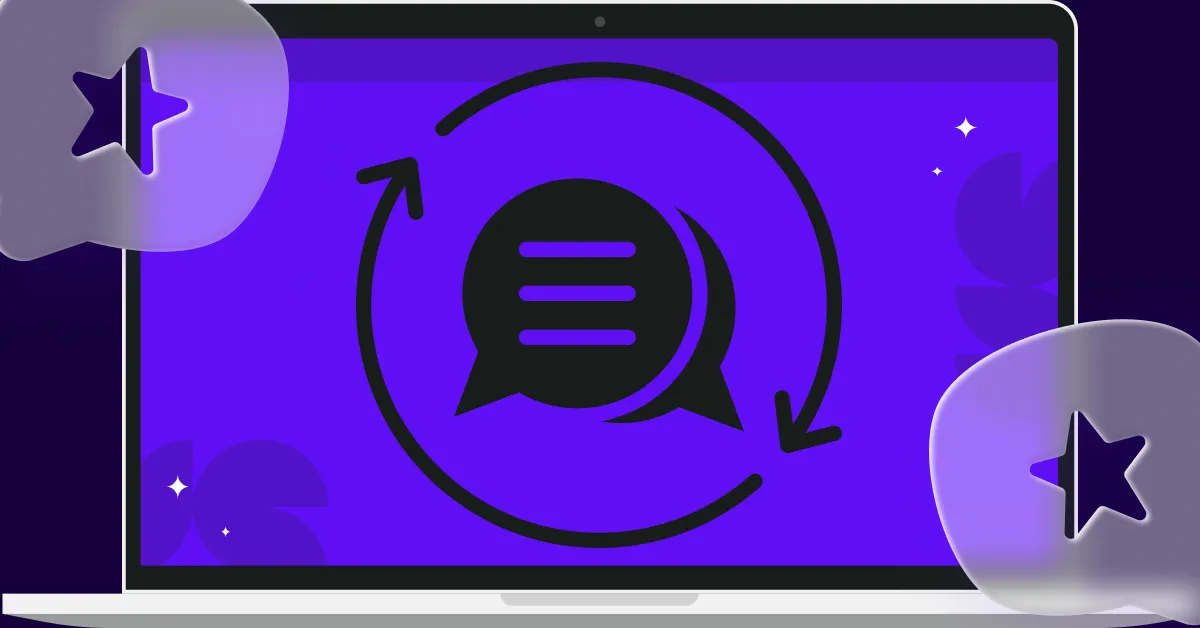Customer experience is the heartbeat of any thriving business, and keeping your finger on the pulse has never been more important. But how do you tune into what thousands of customers are saying?
That's where enterprise feedback management tools come into play. They're like having a superpower that lets you hear and understand every customer whisper, shout, and everything in between.
In this blog, we'll walk you through the top 10 tools that help you collect, analyze, and act on customer feedback with ease in 2025. Get ready to transform those insights into action and watch your business soar!
Key Features to Look for in Enterprise Feedback Management Tools
When searching for the best enterprise feedback management (EFM) tools, there are several key features that are essential for effectively capturing, analyzing, and acting upon customer feedback. They can make or break the success of your feedback strategy, as they directly impact how well you can understand and respond to your customer's needs.

The critical features to consider are:
Integration Capabilities
A seamless integration capability is vital for any enterprise feedback management software. It should be able to easily connect with your existing Customer Relationship Management (CRM) systems, help desks, marketing platforms, and other business tools. This integration allows for the automatic flow of feedback data into your systems, where it can be linked with customer profiles and transaction histories. Doing so gives you a more comprehensive view of your customers, enabling personalized responses and strategic insights that drive business improvement. Look for tools that offer APIs, webhooks, or pre-built integrations with popular business software.
An enterprise feedback management software with robust integration capabilities serves as a central hub for all customer feedback, regardless of where it originates. The ability to integrate with a wide array of software and platforms ensures that feedback data complements and enhances existing customer data, leading to more informed decisions and strategic actions.
What to look for?
- CRM Integration: Integrating with the CRM systems allows for a seamless connection between feedback and customer profiles, sales data, and service histories. This integration ensures that feedback can be attributed to the right customer and that any follow-up actions are well-informed and personalized.
- Marketing Automation Platforms: EFM tools can help tailor marketing campaigns based on customer feedback, improving targeting and messaging by integrating with marketing automation software.
- Helpdesk Software: Integration with helpdesk and customer support platforms enables support teams to address customer issues and track resolution progress directly in response to feedback received.
- Data Analytics Tools: Connecting EFM tools with data analytics platforms can provide deeper insights by combining feedback data with other business intelligence, allowing for more comprehensive reporting and analysis.
- APIs and Webhooks: A robust EFM tool should offer Application Programming Interfaces (APIs) and webhooks that allow for custom integrations with other enterprise systems, enabling businesses to automate workflows and data exchanges.
- Social Media Platforms: Integrating with social media platforms allows businesses to capture and manage customer feedback that comes through these channels, ensuring a comprehensive feedback collection strategy.
- E-commerce Systems: For businesses with an e-commerce component, integrating feedback management with e-commerce systems can help link customer feedback to specific transactions and shopping behavior.
The right enterprise feedback management software should offer pre-built integrations and provide the flexibility to develop custom connections as needed. This ensures that as new technologies emerge or your business evolves, your feedback management system can continue providing a cohesive view of your customer experience and drive meaningful improvements across the enterprise.
Real-Time Analytics
The ability to analyze feedback in real-time is another crucial feature of effective enterprise feedback management software. Real-time analytics allow you to monitor customer sentiment as it happens, enabling immediate action to resolve issues or capitalize on positive feedback. This feature should provide a dashboard that displays key metrics, trends, and patterns, helping you to understand customer experiences across various touchpoints quickly.
This feature allows businesses to quickly detect and respond to customer sentiment, identify trends, and address issues before they escalate, which can significantly enhance customer satisfaction and loyalty.
Here's what to look for in real-time analytics capabilities within an enterprise feedback management software:
- Instant Feedback Processing: The tool should be capable of processing feedback as soon as it is received, allowing for the immediate visibility of customer opinions and concerns.
- Dynamic Dashboards: Look for a tool that offers customizable dashboards that can display key metrics and KPIs in real-time. This enables stakeholders to monitor the customer experience and business performance at a glance.
- Alerts and Notifications: The system should be able to send automatic alerts based on specific criteria, such as negative feedback or mentions of critical issues, ensuring that the right team members can take swift action.
- Sentiment Analysis: Advanced EFM tools employ sentiment analysis to gauge the emotional tone behind customer feedback, providing a deeper understanding of the customer experience beyond mere ratings or scores.
- Trend Detection: Real-time analytics should include trend detection capabilities, helping businesses spot emerging patterns in customer feedback, which can inform product development, service improvements, and customer engagement strategies.
- Cross-Tabulation and Filtering: The ability to cross-tabulate data and apply filters in real-time allows users to segment feedback according to various demographics, customer behaviors, or other relevant criteria, facilitating targeted analysis.
- Integration with Action Management Systems: Real-time analytics becomes even more powerful when integrated with action management systems, enabling businesses to assign tasks, track follow-ups, and measure the impact of responses to customer feedback.
By incorporating real-time analytics into your EFM tool, your enterprise can ensure that it's not just collecting feedback but actively listening to its customers and making informed decisions that can lead to immediate and long-term business benefits.
Multi-Channel Support
You can collect customer feedback in many ways across various channels. The best enterprise feedback management software supports multi-channel feedback collection, including email, social media, web, mobile, and even offline channels like in-store feedback systems or call centers.
This omnichannel approach ensures that you capture the voice of the customer wherever they choose to communicate, providing a holistic view of the customer experience. Multi-channel support also allows you to meet your customers where they are, offering convenience and increasing the likelihood of them providing feedback.
Multi-channel support in EFM tools refers to the ability to collect and manage feedback from various online and offline customer interaction points. This feature is crucial for creating a comprehensive view of customer behavior.

Here's what to look for in multi-channel support:
- Wide Range of Channels: The enterprise feedback management software should support a variety of feedback channels, including, but not limited to, email surveys, website and in-app feedback forms, social media, call centers, and point-of-sale systems. This ensures that customers have the flexibility to provide feedback through their preferred channels.
- Consistent User Experience: Regardless of the channel, the tool should offer a consistent user experience. This means feedback forms and surveys should be optimized for each channel, ensuring ease of use and higher response rates.
- Unified Data Collection: With feedback coming in from multiple channels, it's important that the EFM tool can aggregate all the data into a single repository. This unified approach to data collection simplifies analysis and helps in identifying cross-channel patterns and insights.
- Channel-Specific Customization: The tool should allow for the customization of feedback mechanisms to suit the specific requirements of each channel. For instance, a feedback form on a mobile app might need to be more concise compared to one on a website.
- Integrated Data Analysis: Multi-channel support should extend to the analysis phase, where the tool can break down data by channel but also combine data to give a holistic view of the customer journey across all touchpoints.
- Channel Performance Measurement: The tool should not only collect feedback but also measure the performance of each channel in terms of engagement and satisfaction. This can help businesses invest more wisely in channels that yield the most valuable insights.
In the age of omnichannel customer experiences, it's imperative for businesses to gather feedback across all touchpoints. Multi-channel support in an enterprise feedback management (EFM) tool ensures that companies can listen to their customers no matter where the conversation is happening.
Tool Scalability
As your business grows, your EFM tool should grow with you. Scalability is a feature that cannot be overstated in its importance for an enterprise feedback management tool. As your business grows, the volume of customer feedback and the complexity of data analysis will likely increase.
A scalable EFM tool can handle this growth, adapting to more significant amounts of data, more users, and a broader scope of customer touchpoints without hindering performance.
Key aspects of scalability include
- Capacity to Grow: The tool should be able to manage a growing number of feedback entries and survey responses without any drop in system performance.
- User Management: It should accommodate an increasing number of users—from customer service representatives to data analysts—without compromising on functionality.
- Flexible Architecture: Look for a tool with a flexible, cloud-based architecture that can dynamically allocate resources as needed.
- Modular Design: A modular tool that allows you to add features or integrations as your business needs evolve can be highly beneficial.
By ensuring the EFM tool you choose is scalable, you're investing in a solution that will support your business's long-term feedback management needs.
Enterprise-Grade Data Security
Data security is paramount for any enterprise dealing with customer information. An enterprise feedback management software must have robust security measures in place to protect sensitive feedback data from unauthorized access, breaches, and other security threats.
Consider the following security features when evaluating an EFM tool:
- Data Encryption: The tool should encrypt data both in transit and at rest, safeguarding information as it moves between servers and while it's stored.
- Compliance with Regulations: Ensure the tool complies with relevant data protection regulations such as GDPR, HIPAA, or CCPA, depending on your region and industry.
- Access Controls: It should offer granular user permissions and access controls, allowing you to define who can view or edit certain data within the organization.
- Regular Security Audits: The provider should conduct regular security audits and have a clear protocol for dealing with any potential data breaches.
Benefits of Enterprise Feedback Management Tools
Understanding customer needs and expectations is not just a competitive advantage—it's a business imperative. Enterprise feedback management tools are the linchpin in a strategy focused on customer-centric growth.
They enable organizations to capture, manage, and analyze customer feedback efficiently. Investing in these tools can lead to enhanced customer experiences, drive business growth, and support data-driven decision-making.
Enhance Customer Experience
The cornerstone of any successful business is the customer experience (CX). Enterprise feedback management tools streamline the process of collecting customer insights across various touchpoints, ensuring that no piece of feedback goes unnoticed. By leveraging these tools, businesses can:
- Quickly identify and address customer pain points.
- Track customer satisfaction over time and across different service channels.
- Personalize customer interactions based on feedback, and improve customer loyalty.
By systematically analyzing customer feedback, companies can implement changes that directly impact the customer's journey, ensuring that each interaction is as positive as possible. This ongoing commitment to refining CX solidifies customer relationships and sets the stage for long-term brand advocacy.
Drive Business Growth
User feedback is the fuel for growth-oriented strategies. Enterprise feedback management tools provide a structured approach to gathering actionable insights that can drive business expansion. Here are some of the ways these tools contribute to growth:
- They help identify new market opportunities by revealing unmet customer needs.
- By understanding customer preferences, businesses can tailor their offerings to better match market demand.
- Positive customer experiences, amplified through word-of-mouth and social proof, can attract new customers and open new revenue streams.
In essence, these tools help retain existing customers by enhancing satisfaction and play a crucial role in acquiring new customers and entering new markets.
Make Informed Decisions
Data is a critical asset for any enterprise, but its value lies in the ability to interpret it correctly and make informed decisions. Enterprise feedback management software excels in turning vast amounts of data into digestible insights. This enables decision-makers to:
- Base strategic decisions on real-time customer feedback, minimizing the risks associated with new initiatives.
- Prioritize resources effectively by focusing on areas that have the most significant impact on customer satisfaction and business performance.
- Foster a culture of continuous improvement by using feedback to guide training, development, and process optimization.
10 Best Enterprise Feedback Management Tools for 2024
1. Survicate
Survicate is a powerful yet effortless survey software tool for businesses of all sizes, including enterprise-level organizations.
Survicate provides a user-friendly interface and versatile survey tools that enable enterprises to collect feedback across various touchpoints throughout the customer journey.
These aspects can make it an attractive option for enterprises that prioritize quick deployment and user-friendly interfaces without compromising on powerful feedback collection and analysis capabilities.

Main Features
- Multi-Channel Feedback Collection: Gather feedback through web surveys, mobile app surveys, email surveys, and more.
- Customizable Surveys: Create tailored surveys with branding options to match the look and feel of your business.
- Advanced targeting: Reach the exact group of recipients
- Advanced Real-time Analytics: Analyze responses in real-time with advanced reporting features, including sentiment analysis and trend spotting.
- Survey Logic and Branching: Design complex surveys with skip logic and question branching to ensure relevance and high response rates.
- Net Promoter Score (NPS) surveys, Customer Satisfaction surveys (CSAT), Customer Effort Score surveys (CES), product feedback surveys, and more.
- AI survey creator: by describing what you need in a sentence or two, you can create surveys in about 45 seconds.
- AI Automated Text Answer Analysis: this feature automatically categorizes similar responses together into topics to speed up qualitative feedback analysis
Integrations
Survicate offers integrations with a variety of third-party tools and platforms, including CRM systems like HubSpot and Salesforce, marketing automation tools like Mailchimp, and analytics services like Google Analytics. These integrations help streamline workflows and centralize data for more comprehensive insights.
Security
Survicate is committed to maintaining high-security standards to protect customer data. Survicate is compliant with GDPR, ISO27001, and SOC2 standards. It also offers data encryption, disaster recovery, and periodic penetration tests, among other security features.
2. Medallia
Medallia is a comprehensive experience management platform that specializes in helping enterprises capture feedback from various sources, understand it in depth, and take action to improve the customer experience.
Medallia offers a robust suite of tools designed to gather real-time feedback from customers, employees, and other stakeholders. The platform's powerful analytics engine provides actionable insights, enabling organizations to make data-driven decisions to enhance satisfaction, loyalty, and operational performance.
Main Features
- Omnichannel Feedback Collection: Capture feedback across a wide range of channels, including in-app, web, social media, and contact centers.
- Deep Analytics and Reporting: Utilize advanced AI and machine learning to analyze feedback and generate detailed reports.
- Real-Time Alerts: Receive instant notifications to respond to customer feedback and issues quickly.
- Journey Mapping: Visualize the customer journey and identify key touchpoints for feedback collection and improvement.
- Action Management: Assign, track, and manage follow-up tasks to respond to customer feedback effectively.
Integrations
Medallia integrates with a variety of enterprise systems, such as CRM, ERP, and HRIS, to facilitate seamless data flow and enhance the understanding of customer and employee experiences. The platform's integrations allow for easy sharing of data across systems and teams.
Security
Medallia provides enterprise-grade security to ensure the protection of sensitive data. It is compliant with SOC 2 Type II, GDPR/SCCs, CCPA, and HIPAA in addition to HITRUST, ISO 27001, 27017, 27018, and 27701.
3. Qualtrics
Qualtrics is a sophisticated experience management platform that provides a wide range of tools for collecting and analyzing feedback to help enterprises improve customer, employee, product, and brand experiences.
Main Features
- Advanced Survey Tools: Create and distribute complex surveys with a user-friendly interface.
- Multi-Channel Feedback: Gather user feedback through web, mobile, in-app, and offline channels.
- Predictive Intelligence and Analytics: Utilize machine learning and predictive analytics to analyze feedback data better.
- Customizable Dashboards: Monitor real-time data and trends with fully customizable dashboards.
- Experience Management: Manage the core experiences of business—customers, employees, products, and brands.
Integrations
Qualtrics integrates with numerous other business systems, such as CRM, HRIS, and ERP platforms, through APIs and pre-built connectors, facilitating a cohesive experience management ecosystem.
Security
Qualtrics offers robust security features, including compliance with ISO 27001, SOC2, and GDPR, as well as data encryption both at rest and in transit to ensure the protection of sensitive information.
4. Zonka Feedback
Zonka Feedback's enterprise offer is a full-featured customer and employee feedback platform that helps large organizations capture, analyze, and act on customer data across various touchpoints.
Main Features
- Multi-Channel Feedback Collection: Enables organizations to gather feedback via surveys across different channels like email, SMS, website, and in-app.
- Customizable Feedback Surveys: Provides a wide range of customization options for creating branded surveys that align with the company's look and feel.
- Real-Time Reporting: Delivers immediate insights through dashboards and analytics to track key performance indicators and customer sentiment.
- Action Management: Allows teams to assign tasks, set up workflows, and take action on feedback directly from the platform.
Integrations
Zonka Feedback integrates with CRM systems, marketing automation platforms, helpdesks, and other enterprise tools such as Salesforce, Slack, Zapier, and more to automate feedback collection and data synchronization.
Security
For enterprise clients, Zonka Feedback ensures robust security measures, including SSL encryption, data protection in compliance with GDPR, and secure cloud storage to protect sensitive data.
5. InMoment
Inmoment offers an Experience Improvement (XI) platform that enables companies to listen to, understand, and share customer feedback in order to create better experiences and foster stronger customer relationships.
Main Features
- Multichannel Feedback Collection: Gather feedback across a variety of channels, including surveys, social media, and direct customer interactions.
- Advanced Analytics: Utilize AI-powered analytics to extract meaningful insights from large volumes of feedback data.
- Real-time Reporting: Access dashboards and reports for immediate insights into customer sentiment and trends.
- Action Planning: Develop and track action plans based on customer feedback to ensure continuous improvement.
- Voice of Customer (VoC) Programs: Create structured VoC programs to systematically capture and analyze customer feedback.
Integrations
InMoment's platform can integrate with various CRM systems, marketing platforms, and business intelligence tools, enabling a seamless flow of customer data across enterprise systems.
Security
InMoment emphasizes security and compliance with industry standards, providing data protection measures such as encryption and adherence to global data privacy regulations.
6. UserVoice
UserVoice's enterprise offer is a comprehensive product feedback management tool tailored for large organizations looking to capture, prioritize, and act on customer feedback to drive strategic product decisions.
Main Features
- Feedback Collection: Provides a centralized platform for collecting user feedback from various channels and touchpoints.
- Prioritization and Roadmapping: Helps product teams prioritize feature requests and feedback to inform the product roadmap.
- Feedback Portal: Offers a branded portal where users can submit and vote on feature requests, enhancing community engagement.
- Advanced Analytics: Delivers in-depth insights and reporting to understand user needs and measure the impact of product decisions.
- Customizable Widgets: Enables the integration of feedback widgets into apps or websites for seamless user interaction.
Integrations
UserVoice integrates with a variety of systems, including CRM, project management, and communication tools, such as Salesforce, Jira, Slack, and others, to streamline workflows and connect feedback with existing processes.
Security
The enterprise solution provides robust security features, including SSL encryption, data protection in compliance with industry standards like GDPR, and secure hosting to ensure the safety of customer data.
7. SurveySparrow
SurveySparrow is an engaging online survey platform that turns surveys into conversations. With a focus on user experience, it aims to increase survey completion rates through its conversational interface.
Main Features
- Conversational Interface: Provides a chat-like experience for respondents, making surveys feel more like a dialogue and less like a form.
- Multi-Channel Distribution: Surveys can be shared via web, mobile, social media, and email, ensuring accessibility across various platforms.
- Customizable Templates: Offers a variety of pre-designed templates that can be tailored to fit specific survey needs and branding requirements.
- Reporting and Analytics: Includes real-time reporting tools that help in analyzing survey data and extracting actionable insights.
- NPS Surveys: Specializes in Net Promoter Score (NPS) surveys to gauge customer loyalty and satisfaction.
Integrations
SurveySparrow offers integrations with a range of third-party applications such as Slack, Salesforce, HubSpot, and Zapier, which allows for automation of workflows and syncing of data across different platforms.
Security
The platform provides secure data handling with SSL encryption and ensures compliance with data protection regulations to safeguard respondent privacy.
8. Oracle Customer Experience Cloud
Oracle Customer Experience Cloud (Oracle CX Cloud) is a suite of cloud-based applications that encompass various aspects of customer relationship management (CRM), including sales, marketing, service, and commerce. This suite offers feedback management tools to help enterprises collect and analyze customer insights to improve their customer experience strategies.
Main Features
- Omnichannel Feedback Collection: Collect feedback from various channels such as social media, web, email, and customer support interactions.
- Survey Tools: Create and distribute surveys to gather customer opinions and satisfaction levels.
- Analytics and Reporting: Utilize Oracle's analytics tools to extract actionable insights from feedback data.
- Customer Insights: Combine feedback with customer data to create a comprehensive view of the customer experience.
- Closed-loop Feedback: Implement processes to follow up on customer feedback and address any issues raised.
Integrations
Oracle CX Cloud integrates with other Oracle Cloud applications, such as Oracle Marketing Cloud, Oracle Sales Cloud, and Oracle Service Cloud, providing a seamless experience across all customer touchpoints. Additionally, it can integrate with third-party systems through Oracle Integration Cloud.
Security
Oracle CX Cloud is built with security as a priority, featuring robust data protection measures, compliance with global privacy regulations, and a secure cloud infrastructure to ensure the safety of customer data.
9. SAP Customer Experience
SAP Customer Experience is an integrated suite of CRM solutions designed to provide a comprehensive approach to managing the customer journey, including feedback management.
Main Features
- Omnichannel Feedback Collection: Collect feedback across multiple channels, including web, mobile, and in-person touchpoints.
- Advanced Analytics: Use analytics tools to derive insights from customer feedback data.
- Customer Data Management: Consolidate and manage customer information in a unified customer profile.
- Personalized Engagement: Leverage feedback to create personalized marketing campaigns and customer interactions.
- Feedback Loop Management: Close the loop with customers by following up on their feedback.
Integrations
SAP Customer Experience integrates with various SAP solutions, such as SAP S/4HANA, SAP Marketing Cloud, and SAP Commerce Cloud, as well as third-party systems through SAP Cloud Platform Integration.
Security
SAP Customer Experience provides enterprise-grade security features, including data encryption, compliance with global data protection regulations, and secure cloud infrastructure to ensure customer data is handled safely.
10. Adobe Experience Cloud
Adobe Experience Cloud is a comprehensive set of marketing, analytics, advertising, and e-commerce applications designed to help enterprises craft a personalized customer experience. While feedback management is not the core functionality, it is an essential component of the platform.
Main Features
- Multifaceted Data Collection: Gather feedback from various sources, including online and offline channels, to obtain a holistic view of the customer experience.
- Real-Time Analytics: Utilize Adobe Analytics to gain real-time insights from customer feedback data.
- Personalization: Leverage Adobe Target to personalize content and experiences based on customer feedback and behavior.
- Content Management: Manage and optimize content in response to customer feedback using Adobe Experience Manager.
- Customer Journey Management: Track and manage the customer journey, including feedback touchpoints, with Adobe Campaign.
Integrations
Adobe Experience Cloud offers integrations with its own suite of tools, including Adobe Analytics, Adobe Target, and Adobe Experience Manager, as well as with third-party systems through Adobe I/O, which is Adobe's cross-cloud developer portal.
Security
Adobe Experience Cloud provides robust security measures that include data encryption, compliance with global privacy laws, and secure cloud services infrastructure to protect sensitive customer information.
How to Choose the Right Enterprise Feedback Management Tool for Your Business
Selecting the right enterprise feedback management tool is crucial for businesses looking to harness customer insights for improved decision-making and enhanced customer experiences. With the market offering a plethora of options, it's important to take a strategic approach to choose a tool that aligns with your business objectives and operational capabilities. Below are key considerations to guide you in making an informed decision.
Assess Your Specific Needs
Before diving into the sea of available enterprise feedback management tools, take a step back and evaluate what you aim to achieve with the system. Determine the scope of feedback you need to collect—be it customer satisfaction, employee engagement, product feedback, or all of the above.
Consider the volume of data you expect to handle and the level of detail required for your analytics. Identify the key features you need, such as survey customization, multichannel feedback collection, real-time analytics, and reporting capabilities. By understanding your specific requirements, you can narrow down the options to those that offer the functionalities that matter most to your organization.
Consider Your Tech Ecosystem
The enterprise feedback management tool you choose should seamlessly integrate with your existing technology stack. Compatibility with your current software, such as CRM, ERP, or marketing automation platforms, is essential to ensure smooth workflows and data synchronization.
Look for tools that offer APIs, and native integrations or can be easily connected through middleware solutions. A tool that fits well within your tech ecosystem will enhance data sharing across departments, provide a unified view of customer insights, and reduce the need for manual data transfers, thereby increasing efficiency and reducing the likelihood of errors.
Evaluate Customer Support and Service
The level of customer support and service provided by the enterprise feedback management tool vendor can significantly impact your experience and success with the product. Consider vendors who offer comprehensive support, including onboarding, training, and ongoing assistance.
Ensure that the support team is responsive and can provide help when needed, whether through live chat, phone support, or a dedicated account manager.
Additionally, check for the availability of resources such as knowledge bases, user communities, and best practice guides that can help you maximize the value of your investment. A vendor with a strong commitment to customer service will help you overcome any technical challenges and partner with you to ensure you achieve your feedback management goals.
Gather Customer Feedback with Enterprise Feedback Management Software Tools
Collecting customer feedback is essential for any business looking to improve. Thankfully, enterprise feedback management software makes this process straightforward. It allows you to easily ask questions and gather the information you need to enhance your services or products.
Designed to be simple to use, these tools don't require advanced technical knowledge to get started. With them, you can quickly understand your customers' needs and expectations. This understanding is key to driving your business forward and keeping your customers satisfied.
Ready to get a clearer picture of what your customers think? Consider giving Survicate a try. You can start with a free 10-day trial and gather valuable customer insights immediately.









.webp)

.png)



.svg)

.svg)



